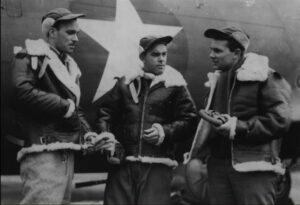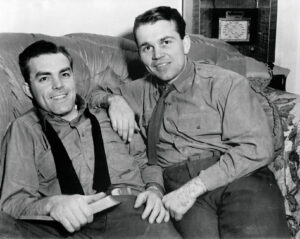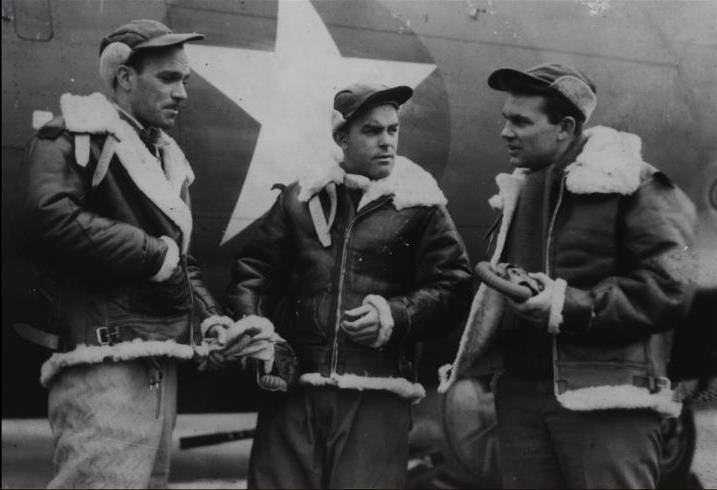Stripes in Normandy: A Reporter’s Journey
By David Kiley

On June 9, 1944, Sgt. Charles Kiley, reporter for The Stars and Stripes wrote to his fiancée, Billee Gray, from a Liberty Ship steaming toward Normandy:
“[We are} bound for what the radio says is “our beachead in Normandy. Looking at the map makes it appear to be a simple process of getting from England to France…This morning brought one of the most impressive sights I have ever seen, as far as strength in merchant shipping and warships is concerned. Passing a US battleship and two cruisers at a 200-yard distance, we watched them fire salvo after salvo after salvo at targets miles out of sight on land. Planes of every description have been soaring overhead in pairs, quarters and huge formations. In the distance, we heard shellfire on land. And in the midst of it all, a chaplain aboard spread his white altar linen over an oil-stained canvas on top of a hatch and celebrated mass.”
Charles Kiley was part of a group of six Stars and Stripes staff whose mission was to land on the Normandy beaches and begin publishing the paper on the continent as soon as possible. They were led by Captain William McNamara, a young officer who would later become publisher of the paper.
The first Continental edition of the paper has a crude, but heroic start. Kiley was the primary news gatherer. Upon landing at Omaha Beach, Kiley and his mates had many boxes of mimeograph paper, with a pre-printed header: The Stars and Stripes: Beachhead Edition. There is one known copy of this paper that has survived, dated June 16, 1944 and is held in The New York Public Library.
For a month or so, Kiley roamed the beaches in a Jeep with a typewriter, notebook, pencils and radio. He picked up information from supply-line soldiers who were traveling inland from the beach transporting ammunition, medical supplies, food and gasoline. He also monitored the BBC and snatched some reports from their field reporters and incorporated them into his copy. When he typed his stories into the mimeo stencil, one of the Stripes staffers on the invasion team ran off the crude papers. Thousands of copies were bundled and then given to the supply trucks going into the battle zone as the Allies advanced through hedgerow country toward Caen.
McNamara, after the war, was at a gathering with General Omar Bradley. “Gen. Bradley made the comment that the Stars and Stripes in those early days was one of the most valuable contributions to troop morale because the men didn’t know if they were winning or losing…. But it’s important to remember and record what those who served have gone through.”

While roaming Normandy beaches, Kiley would recall to his son in later years, a magazine reporter approached a cluster of soldiers who were finally granted permission to have a beach fire to keep warm at night. “He introduced himself as ‘Hemingway.’” Kiley was a bit taken aback; he would remember. “Hemingway was writing about the invasion for The Saturday Evening Post or Colliers, as he was looking to get the lay of things, so we got him oriented. I saw him again years later in Havana where he turned up at a press junket that I was on at the opening of the new Hilton Hotel, and we reminisced for a few minutes about meeting on Omaha Beach, or it may have been Utah,” he recalled.
Kiley and Andy Rooney occupied a flat in St. Mere Eglise for about four weeks while the mimeo-paper was producing, and the other members of the staff looked for a printing plant to produce the first real, broadsheet Continental Edition of the war.
That paper was produced on July 4, 1944 in Cherbourg, a two-page broadsheet.
July 6, 1944:
Charles writing to his fiancée Billee:
“The day after Cherbourg fell, our somewhat small editorial staff moved in. There is, or was, a small newspaper plant here and after negotiations with the owner, we decided to try and turn out our first paper in France. The mechanical facilities and incoming communications system only allowed for a two-page paper. We got the first one out on July 4 and we will publish every day until the paper stock runs out or we move to another spot.”
Before the Cherbourg facility was secured, there was an attempt to set up the paper in the town of Carentan. It did not turn out well. Publisher Col. Llewellan erected a Stars and Stripes banner over the doorway of a building where the printing presses were held. But he did so before Carentan was completely secured by Allied troops. A German contingent spotted the banner and shelled the building.
Kiley and the staff worked across France, North to South, as the Allies advanced closer to Paris. Soldiers, including Stripers, were rotated home for three-month leaves. Kiley got his orders at the end of July to go back to New York for a respite after covering the war for almost two years. While home, Kiley and Billee got married on August17. He would work in the Stripes’ New York office until the end of October, being sent to St. Louis in October to cover the only World Series in history between the St. Louis Cardinals and St. Louis Browns. Time Magazine would mention Kiley’s presence at the series and described him as a lookalike of the actor Pat O’Brien.
It’s not the only time Kiley would be witness to history, as he would be assigned to General Eisenhower in April 1945, which put him in position to be the worldwide pool reporter in Reims for the surrender negotiations between the Germans and Eisenhower’s senior staff. He would be the only reporter on the premises for some 20 hours of negotiations before the signing ceremony.
David Kiley is the son of Charles F. Kiley. He is a journalist and author. David Kiley, Anne Kiley and Thomas Pellechia co-authored Writing The War, Chronicles of a World War II Correspondent, endorsed by Tom Brokaw—“A superb and important contribution to World War II History.”
Stars and Stripes Article: Stars and Stripes reporter had a front-row seat to the end of World War II

